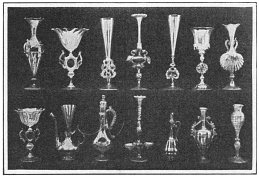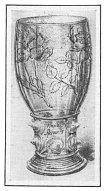
Up: Glassmaking

Glass & Glass-Making
8 of 28
|
|

| |

VENETIAN GLASS (16th century)
|
lapis lazuli (lazurite
stone, also called blue spar).
Crusaders often brought home specimens, taking
care to fill them with earth from the Holy Land, which kept them from
breaking and, besides, made them more precious. The famous "Luck of
Eden Hall" is one of these.
The industry suddenly ceased when
Tamerlane captured Damascus (about
1370) and took the glass-makers to Samarkand. In
after years travelers spoke of the gorgeous glass they saw there. This
ware continued to be made in a few places; but it was finally surpassed
by the vogue of the new Venetian "cristallo."
Venetian Glass
Venice had glass-making under artistic control
at a very early period. An old writer, Carlo Marin, said that "Venice
loved the art of glass-making as the apple of her eye." And he was
right. Venice not only took pride in this industry, but it was one
important source of her vast wealth.
The Venetians ceased to make enameled glass after
the Arabian style at the beginning of the sixteenth century; for they had
learned to make an absolutely colorless and transparent glass, capable of
being blown to

A DUTCH SEA-GREEN
GOBLET
Decorated by Anna Visscher.
In the Ryks Museum,
Amsterdam
|
the thinness of a wafer and of being worked into every
variety of form. Everybody wanted specimens of the thin, airy "metal,"
blown into lovely shapes and fantastically decorated with flowers,
sea-horses and dragons with spreading wings, or exhibiting spiral lines
of milk-white, or colored threads.
The artistic beauty of Venetian glass, made in
Murano (an island near Venice), depends entirely on the skill of the
glass-blower rather than on that of the enameler, engraver, or cutter.
The Murano workmen sought perfection of form, delicacy of color and the
fairy lightness of the soap-bubble.
This exquisite glass was imitated everywhere,
until it was pushed aside by Bohemian glass. Murano glass-making was
revived in 1856 by Dr. Antonio Salviati,
a prominent lawyer of Venice, who gave his time and fortune to the
restoration of an art that was not dead, but sleeping.
|
|